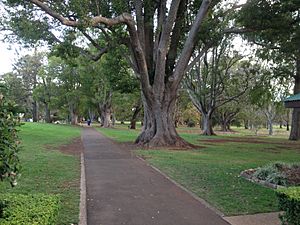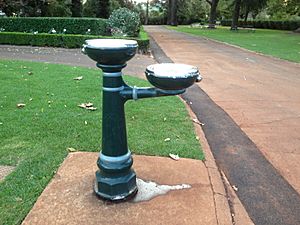Queens Park, Toowoomba facts for kids
Quick facts for kids Queens Park, Toowoomba |
|
|---|---|

Park path, 2014
|
|
| Location | 43-79 Lindsay Street, East Toowoomba, Toowoomba, Toowoomba Region, Queensland, Australia |
| Design period | 1870s - 1890s (late 19th century) |
| Built | 1875 - 1970s |
| Official name: Toowoomba Queens Park and Botanic Gardens, Toowoomba Queen's Park | |
| Type | state heritage (landscape, built) |
| Designated | 27 April 2001 |
| Reference no. | 601607 |
| Significant period | 1869, 1875 (historical) 1869- ongoing (social) |
| Significant components | cannon, garden - bed/s, pathway/walkway, wall/s, sports field/oval/playing field, tree groups - avenue of, trees/plantings, memorial/monument |
| Lua error in Module:Location_map at line 420: attempt to index field 'wikibase' (a nil value). | |
Queens Park is a very old and special park in East Toowoomba, Toowoomba, Queensland, Australia. It includes a beautiful botanic garden. The park was built between 1875 and the 1970s. It is also known as Toowoomba Botanic Gardens. This important place was added to the Queensland Heritage Register on 27 April 2001.
Contents
Park History: How Queens Park Started
The land for Queens Park and the Botanic Gardens in Toowoomba was set aside for public use in 1869. However, it wasn't until the mid-1870s that the park and gardens were properly created. Queens Park was designed for people to relax and play. The Botanic Gardens were for studying plants and nature.
Why Parks and Gardens Were Important
In the 1800s, public parks became very popular. They gave people who didn't have their own gardens a place to enjoy the outdoors. Parks also helped make crowded towns look nicer. Botanic Gardens were created because people were very interested in understanding the natural world.
A Botanic Garden was started in Brisbane in 1855. This was part of a worldwide trend to study plants. These gardens were especially important in new colonies. They helped scientists learn about how plants grew in different places. The Brisbane Botanic Gardens also had smaller gardens in other towns, like Toowoomba. These "branch gardens" helped collect information about plants across Queensland.
Early Efforts to Create the Park
After Toowoomba became a town in 1860, a local leader named William Henry Groom worked hard to get land for a public park. He wanted Toowoomba to grow into a big city. In 1861, some land was set aside, but it wasn't the final spot. By 1869, the current L-shaped piece of land was chosen. It was near the center of the growing town.
For many years, the land was used for grazing animals and digging up clay for bricks. This left the park in poor condition, full of holes. At first, the Queensland Government controlled the park. But by the late 1860s, the Toowoomba Council took over. In 1892, the Council officially owned the land. The only rule was that it had to stay a recreation ground forever.
Developing the Park and Gardens
Work on Queens Park began slowly. In 1873, the Council received money to build timber fences. Fences were important because they kept wandering animals out. They also helped control when the park was open. The Council also worked to drain swampy areas, including parts of Queens Park.
Even though the Council didn't plan a Botanic Garden at first, William Groom convinced the government to give money for one in 1874. Walter Hill, the curator of the Brisbane Botanic Gardens, helped set up branch gardens across Queensland. Toowoomba's Botanic Gardens was the second of eight such gardens. Walter Hill helped choose locations and supported the local councils. He suggested that part of Queens Park be used to test plants that could be valuable for business. This section was at the northern end of the park.
The Botanic Gardens Take Shape
With the Botanic Gardens started, a curator named Edward Way was hired. By late 1875, the gardens were well-established. Edward Way worked with Walter Hill on the layout and planting. Local newspapers reported that the park and gardens had new paths, flower beds, and nurseries for different trees. They also had a bush house.
Throughout the late 1870s, they planted and tested many types of trees. In 1880, they did experiments to see how plants grew in Toowoomba's climate. They would remove and replace trees to keep testing new species. The results were shared in local papers and sent to Brisbane. This helped build a lot of knowledge about Queensland's plants.
Queens Park for Sports and Fun
Once the Botanic Gardens were doing well, the Council focused on Queens Park. It still had holes and not much plant life. By 1881, the Caledonian Sports Association used the park for sports. They built a small grandstand and a running track. Many sports clubs have used Queens Park over the years. Today, there are still many sports fields, especially on the western side. The park was leveled in the 1930s, which made it even better for sports.
Queens Park also had public swimming baths from 1894 until 1964. They were built in the southwest corner of the park. Building the baths there also helped drain a swampy area. In 1937, the baths were made bigger and better. They were removed in 1964 and replaced with the Vera Lacaze Memorial Park, a modern garden area.
Later Developments and Features
In the 1890s, more buildings were added to the Botanic Gardens. These included a curator's cottage, a kiosk, a bandstand, and even a small zoo in 1900. None of these old buildings are still there today.
One famous feature is the Camphor laurel avenue. This path, lined with trees, runs from Margaret Street north into the Gardens. It was planted by 1891. Around the same time, the Alfred Thomas Memorial was moved to the center of a circular path near the northern entrance. Alfred Thomas was important because he oversaw the building of the railway to Toowoomba. A cannon was placed near the memorial in 1900.
In the 1920s, Toowoomba became known as the "garden city" of Queensland. Queens Park and the Botanic Gardens were the best examples of this. The gardens had a large glasshouse and gravel paths. However, parts of Queens Park were still used for garbage disposal until 1931. People also leased parts of the park to graze horses until the 1920s.
By the 1940s, a children's playground was built in Queens Park. This followed a trend of building playgrounds across the state. They were designed to give children a proper place to play and exercise.
From the 1950s to the 1970s, many changes happened. New buildings were constructed, and old ones were removed. The swimming baths were replaced with a garden and toilets. A big change in the 1970s was replacing the old fence around the Botanic Gardens with a low sandstone wall. The old kiosk, greenhouse, bush-house, and bandstand were also removed.
Park Features: What You Can See Today
Toowoomba Queens Park and the Botanic Gardens are on a large, L-shaped piece of land. It is surrounded by Margaret, Hume, Godsall, Campbell, and Lindsay Streets. The Botanic Gardens part is a smaller rectangle at the northern end.
Trees and Plants
Many of the original trees are still in the park and gardens. The most noticeable is the Camphor laurel avenue. This is a walkway lined with old Camphor laurel trees, running north to south. You can also see many other old trees, including Bottle trees, Bunya pines, Chinese elm, English oak, Jacaranda, and Norfolk Island pine.
The Botanic Gardens Area
The Botanic Gardens have a more formal design. You'll find large trees surrounded by garden beds in neat shapes. There are also hedges and tree-lined paths. The main point of interest is the Thomas Memorial. It sits in the middle of a large, round garden area. Next to the memorial is a small cannon. The paths in the garden are made of gravel and often have narrow flower beds along their edges.
The gardens are surrounded by a low stone fence with openings for entrances. A large, new entrance gate is on the Lindsay Street side. It's made of rough sandstone and has four round stone designs. Above the gate, it says "Toowoomba Botanic Gardens Est'd 1875." Just inside this gate, there's another new feature: a doorway from an old demolished building. It has two granite columns with fancy tops and a stone beam connecting them. There is also a new toilet block in the gardens.
Queens Park Area
Queens Park is more open and less formal. The most obvious trees are those forming the Camphor laurel avenue. There are also large, old trees along the eastern and northern edges of the park. You'll see several large playing fields throughout the park. These fields have small buildings nearby for facilities. In the southwest corner, there's a more formal area called the Vera Lacaze Gardens. It has a bridge between grassy mounds and a toilet block. The western end of the park, closer to the city center, has fewer trees.
Why Queens Park is Special: Heritage Listing
Toowoomba Queens Park and Botanic Gardens were added to the Queensland Heritage Register on 27 April 2001. This means it's a very important place for several reasons:
A Look into Queensland's Past
The park and gardens show how Queensland developed over time. They are a great example of a public recreation area from the 1800s. The Botanic Gardens also show how scientific centers were created to study plants. This knowledge helped the colony grow.
A Classic Example of Parks and Gardens
The park and gardens show what 19th-century public parks and botanic gardens were like. They still have early plantings, tree-lined paths, memorials, and parts of their original design.
Beautiful and Appealing
The park and gardens are very beautiful. They are a large city park with both formal and informal areas. All parts are filled with old and impressive trees. Special features like the Camphor laurel avenue and other individual trees add to its beauty.
Important to the Community
This place has been a popular spot for public recreation for a long time. It also shows how the Queensland Government started letting local councils manage public lands.
Connected to Important People
The park and gardens have memorials and special garden areas that honor important local people. These include the Thomas Memorial and the Vera Lacaze Gardens. The park is also linked to Walter Hill, who helped start and design the Botanic Gardens. He was key in creating a network of botanic gardens across Queensland. This helped us learn a lot about plants and Queensland's geography. William Groom, who was the Mayor of Toowoomba for six years, was also very involved in creating and developing Queens Park and Gardens.
Gallery







